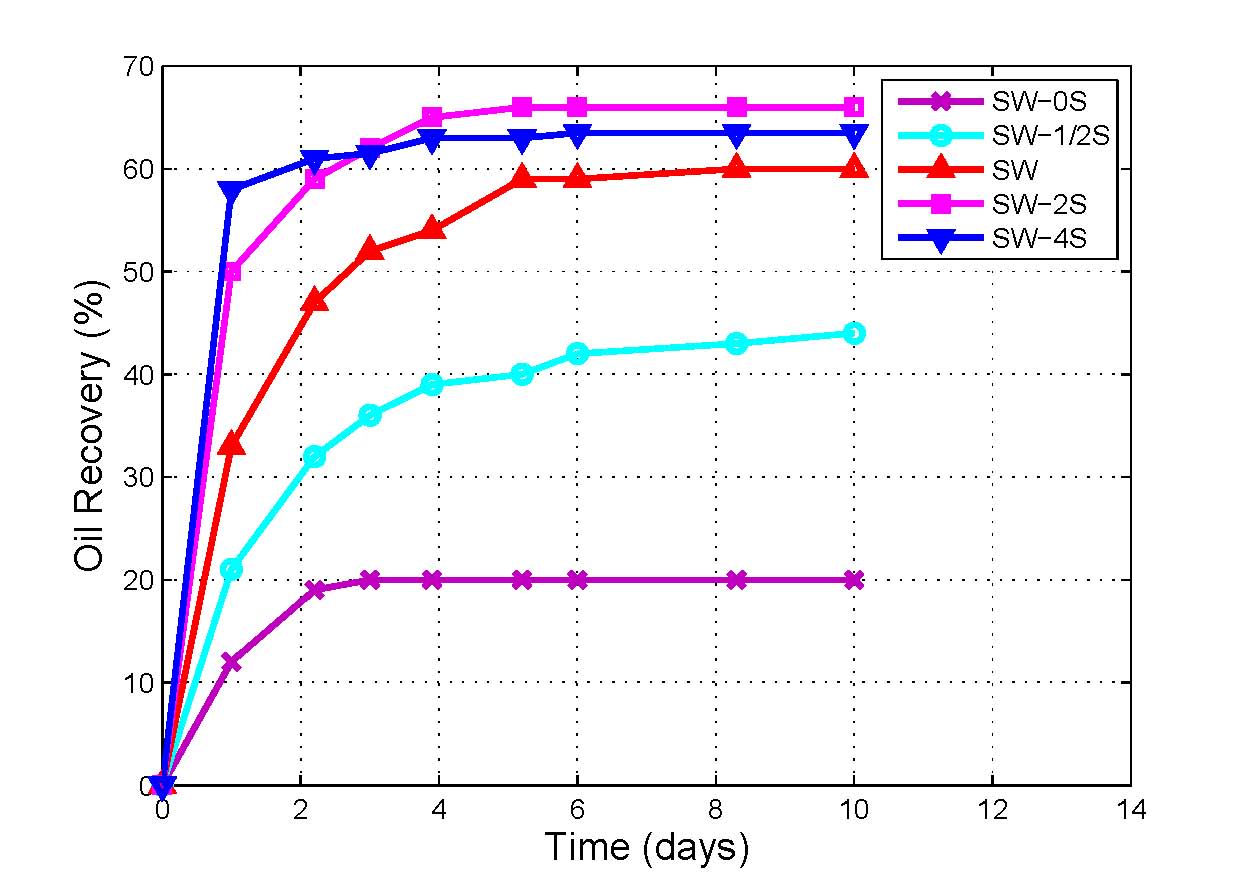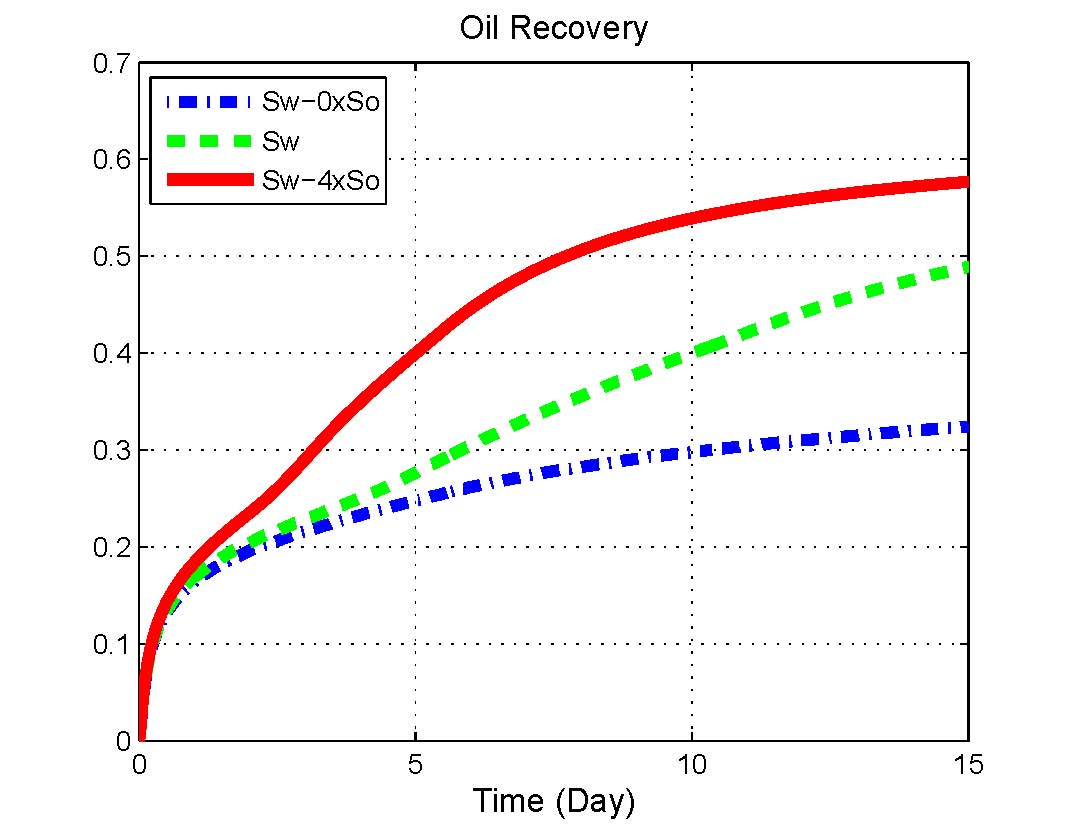***************************************************************************************************************************
Transport-reaction models for porous media flow
- Currently, focus is on convection-diffusion-reaction models relevant for the study of "chalk weakening effects" and "optimized water chemistry for enhanced oil recovery" (more details are given below). Mathematical models are developed for a better understanding of some intricate and complicated transport-reaction type of problems with great practical importance for the management of various oil-fields. Focus is on modeling of lab experiments as well as use of such models to seek knowledge about behavior on reservoir scale.
Generally
Transport-reaction in terms of convection-diffusion-reaction type of models appear in many different applications like modeling of water-rock systems, biological systems involving cell-motion phenomena, various aspects of chemical engineering, material science, and even problems within financial engineering. The subtle interplay between motion and change in terms of reactions gives rise to an astounding richness of natural phenomena, and often manifests itself in the emergence of intricate spatial or temporal patterns.
Some nice examples of processes which involve a combination of flow and chemical reactions are illustrated in the figures below from the book "Chemistry in Motion" by Prof B.A. Grzybowski.
These figures show different examples of diffusion-reaction processes for animate as well as inanimate systems and how the combined effect of flow and chemical reactions may give rise to characteristic patterns.
Water-rock chemistry
The flow of aqueous reacting solutes through soil or porous rock involves a complex system of geochemical, hydrological, and biochemical processes and is of fundamental importance in many different contexts.
"Chalk weakening effects"
Compaction of chalk reservoirs is experienced at the Ekofisk field in the North Sea, and is not only a result of an increase in effective stresses linked to pore pressure depletion during oil recovery. There is, however, an additional impact of the seawater injection when water replaces oil in chalks; it causes enhanced compaction of the rock, which further has shown to induce additional seabed subsidence. This phenomenon is often referred to as the water weakening effect on chalks. Examples of issues that we deal with in this context are:
- Seek to develop mathematical models that are general enough to capture important mechanisms associated with water-rock interactions (dissolution/precipitation and/or surface chemistry) relevant for chalk weakening effects.
- Provide evaluation of the models by comparing with lab experiments carried out at UiS.
- Gain some basic insight into characteristic and fundamental features of the models by considering appropriate discrete versions of the models. Typically, we base the model on known parameters and use it to infer insight into quantitative behaviour that is not easy to measure, like in situ concentrations.
We also seek to use mathematical methods to analyse the models (in addition to numerical calculations) and extract more qualitative insight into the behaviour predicted by the model. In particular, we are interested in issues like
- How to transfer insight from experimental studies on core plugs to a larger scale relevant for reservoir flow.
- What is the long-time behavior?
- Look for special wave type solutions.
Another issue that naturally comes into play as a part of this activity is to explore different discretization techniques in order to find the most efficient ways to solve the systems of PDEs in question.
An important motivation for the modeling activity is that it can provide visualizations of possible scenarios relevant for the lab experiments that in turn open up for new ideas about design of further experiments.
We are also interested in exploring different coupling mechansims between the stress-strain behavior and the water-rock chemical interaction.
"Optimized water chemistry for enhanced oil recovery"
It has been observed through numerous lab experiments that the oil recovery depends on the brine composition both for chalk and sandstone core plugs.
See the figure above for a visualization of this phenomenon. In view of these experimental observations a main purpose is to deal with the following questions:
- How to explain that different (steady state) oil recovery levels are reached depending on the chosen brine composition? What are fundamental mechanisms behind this behavior?
The objective of this research activity is to bring forth mathematical models that can allow for systematic and quantitative studies of the relation between brine
composition and produced oil as observed in a lab scale setting. In particular, we suggest models by combining two different modeling components:
- Modeling of water-rock interaction (dissolution/precipitation and/or surface chemistry) in the context of geo-chemistry.
- Modeling of two-phase water-oil transport effects by means of relative permeability and capillary pressure curves. These curves depend on the wetting state of the core plug.
In particular, a model has been formulated that takes the form of a system of convection-diffusion-reaction equations that are inherently nonlinear and strongly coupled.
It should also be noted that generally speaking transport-reaction phenomena typically are inherently nonlinear, and the participating chemicals may evolve into final structures
via nontrivial and sometimes counter-intuitive ways. Consequently, much work remains to be done to carefully evaluate different aspects of the proposed models like:
- Suggest and explore different coupling mechanisms for the relation between the water-rock interaction and changes in the wetting state.
- Careful evaluation of the models in view of lab experiments that has been carried out before at UiS/IRIS as well as new experiments.
- Design of efficient numerical discretizations of the resulting PDE system.
- Investigations to obtain a better understanding of possible pattern formation mechanisms.
- Long-time behavior important for reservoir considerations.
- Study how solutions are sensitive for various parameters.
Based on the development of models for lab scale experiments we will in a next phase put together models relevant for reservoir scale considerations by using the lab scale models as building blocks.
The modeling activity is relevant for the study of:
- Improved oil recovery in chalk reservoirs.
- Oil recovery and its dependence on the brine composition in sandstone (low salinity)
Relevant publications:
[1] L.Yu, S. Evje, I. Fjelde, H. Kleppe, T. Kaarstad, S.M. Skjaeveland,
Modelling of wettability alteration processes in carbonate oil reservoirs, Networks and Heterogeneous Media Vol 3 (1), 2008.
[2] L.Yu, S. Evje, I. Fjelde, H. Kleppe, T. Kaarstad, S.M. Skjaeveland,
Spontaneous Imbibition of Seawater into Preferentially Oil-Wet Chalk Cores - Experiments and Simulations, Journal Pet. Sci. Eng., accepted in 2008.
[3] S. Evje, A. Hiorth, M. Madland, and R. Korsnes,
A mathematical model relevant for weakening of chalk reservoirs due to chemical reactions, Networks and Heterogeneous Media Vol 4 (4), 2009.
[4] S. Evje, A. Hiorth
A mathematical model for dynamic wettability alteration controlled by water-rock chemistry, Networks and Heterogeneous Media, to appear, 2010.
***************************************************************************************************************************







